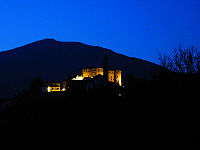
Castello di Compiano
Encyclopedia

Compiano
Compiano is a medieval walled town in the Taro Valley , a 50 minute-drive to the Ligurian Sea and to Parma.The top of Compiano's hill is home to the medieval Castello di Compiano.-History:...
's hill, in the province of Parma
Province of Parma
The Province of Parma is a province in the Emilia-Romagna region of Italy. Its capital is the city of Parma.It has an area of 3,449 km², and a total population of 413,198...
, northern Italy
Italy
Italy , officially the Italian Republic languages]] under the European Charter for Regional or Minority Languages. In each of these, Italy's official name is as follows:;;;;;;;;), is a unitary parliamentary republic in South-Central Europe. To the north it borders France, Switzerland, Austria and...
. It is believed to have been built in the early Middles Ages by the Lombards
Lombards
The Lombards , also referred to as Longobards, were a Germanic tribe of Scandinavian origin, who from 568 to 774 ruled a Kingdom in Italy...
, on the road which links the neighbouring Emilia
Emilia (region of Italy)
Emilia is a historical region of northern Italy which approximately corresponds to the western and north-eastern portions of today’s Emilia-Romagna region...
and Liguria
Liguria
Liguria is a coastal region of north-western Italy, the third smallest of the Italian regions. Its capital is Genoa. It is a popular region with tourists for its beautiful beaches, picturesque little towns, and good food.-Geography:...
.
In first belonged to the Malaspina family, then to the Commune of Piacenza
Piacenza
Piacenza is a city and comune in the Emilia-Romagna region of northern Italy. It is the capital of the province of Piacenza...
and, finally, to the Landi family which ruled the area for 425 consecutive years, eventually forming a small independent principality, the Landi State.
Between the 16th and the 17th centuries Compiano was in its prime, and minted its own currency, opened state schools and started a pawn system.
In the 18th century Compiano passed from the Farnese to the Borbone family, and was then annexed to the realm of Maria Luigia of Austria, then Duchess of Parma, who used the castle as a State prison for Carbonari captives in 1821.
Before World War II it was used as a girl's orphanage. After the war ended, the school was closed down and the castle was bought by Marchioness Lina Raimondi Gambarotta who, after her death in 1987, left it to the Compiano's Municipality.
Built on a rocky spur which dominates the river Taro, the castle is similar to a projection from the surrounding fortified walls.

